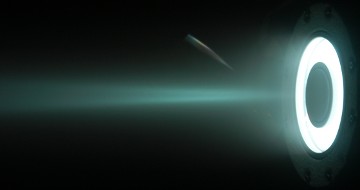
Xenon
Xenon General
| Name:Xenon | Symbol:Xe |
| Type:Noble Gas | Atomic weight:131.30 |
| Density @ 293 K:0.00588 g/cm3 | Atomic volume:37.3 cm3/mol |
|
Discovered:
Xenon was discovered in 1898 by William Ramsay and Morris Travers during experiments with liquid air. The name comes from the Greek word 'xenos', meaning stranger. |
|
Xenon States
| State (s, l, g): gas | |
| Melting point:161.3 K (-118.8 °C) | Boiling point:165 K (-108.1 °C) |
Xenon Energies
| Specific heat capacity:0.158 J g-1 K-1 | Heat of atomization:0 kJ mol-1 |
| Heat of fusion:2.297 kJ mol-1 | Heat of vaporization :12.636 kJ mol-1 |
| 1st ionization energy:1170.4 kJ mol-1 | 2nd ionization energy:2046.4 kJ mol-1 |
| 3rd ionization energy:3097.2 kJ mol-1 | Electron affinity:kJ mol-1 |
Xenon Oxidation & Electrons
| Shells:2,8,18,18,8 | Electron configuration:[Kr] 4d10 5s2 5p6 |
| Minimum oxidation number: 0 | Maximum oxidation number:8 |
| Min. common oxidation no.: 0 | Max. common oxidation no.:6 |
| Electronegativity (Pauling Scale):2.6 | Polarizability volume:4 Å3 |
Xenon Appearance & Characteristics
| Structure:fcc: face-centered cubic | Color: Colorless |
| Hardness:mohs | |
|
Harmful effects:
Xenon is not considered to be toxic but many of its compounds are toxic as a result of their strong oxidizing properties. |
|
|
Characteristics:
Xenon is a rare, colorless, odorless heavy gas. Xenon is inert towards most chemicals. Many compounds of xenon have now been made, principally with fluorine or oxygen. Both oxides, xenon trioxide (XeO3) and xenon tetroxide (XeO4) are highly explosive. Uses: Xenon is used in photographic flashes, in high pressure arc lamps for motion picture projection, and in high pressure arc lamps to produce ultraviolet light. It is used in instruments for radiation detection, e.g., neutron and X-ray counters and bubble chambers. Xenon is used in medicine as a general anaesthetic and in medical imaging. Modern ion thrusters for space travel use inert gases - especially xenon - for propellant, so there is no risk of the explosions associated with chemical propulsion. |
|
Xenon Reactions
| Reaction with air: none | Reaction with 6 M HCl: none |
| Reaction with 15 M HNO3: none | Reaction with 6 M NaOH: none |
Xenon Compounds
| Oxide(s):XeO3 , XeO4 | Chloride(s): none |
| Hydride(s): none |
Xenon Radius
| Atomic radius:108 pm | Ionic radius (1+ ion): pm |
| Ionic radius (2+ ion): pm | Ionic radius (3+ ion): pm |
| Ionic radius (2- ion): pm | Ionic radius (1- ion): pm |
Xenon Conductivity
| Thermal conductivity: 0.00565 W m-1 K-1 | Electrical conductivity:S cm-1 |
Xenon Abundance & Isotopes
| Abundance earth's crust: 30 parts per trillion by weight, 5 parts per trillion by moles | |
| Abundance solar system:parts per million by weight, parts per million by moles | |
| Cost, pure:$120 per 100g | |
| Cost, bulk:$ per 100g | |
|
Source:
Xenon is a trace gas in Earth's atmosphere. It is obtained commercially by fractional distillation of liquid air. |
|
|
Isotopes:
Xenon has 36 isotopes whose half-lives are known, with mass numbers 110 to 145. Of these, seven are stable: 126Xe, 128Xe, 129Xe, 130Xe, 131Xe, 132Xe and 134Xe. |
|
Xenon Other
|
Other:
|
|
Prev: Iodine Next: Cesium |